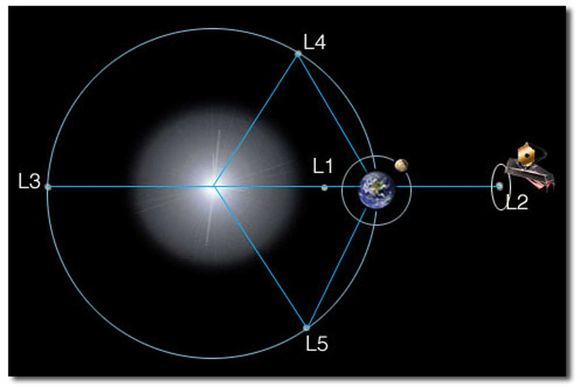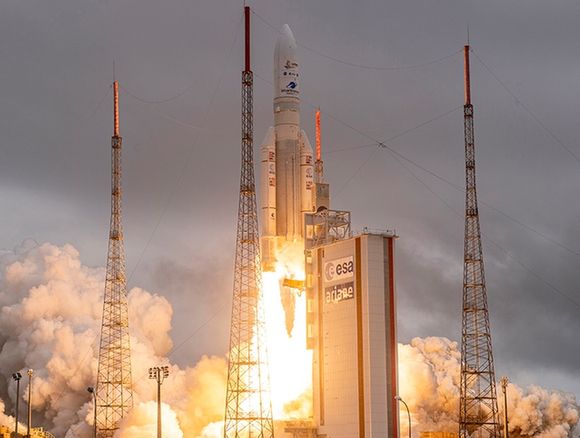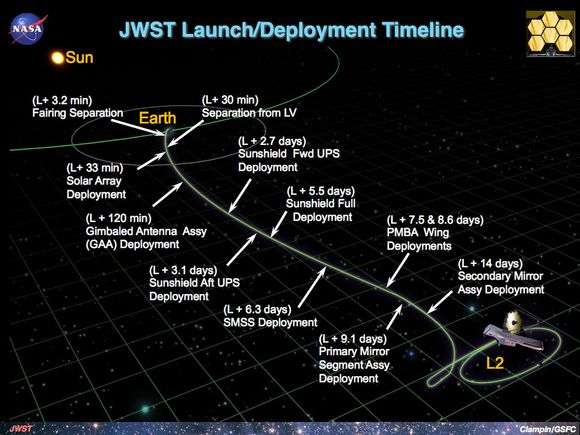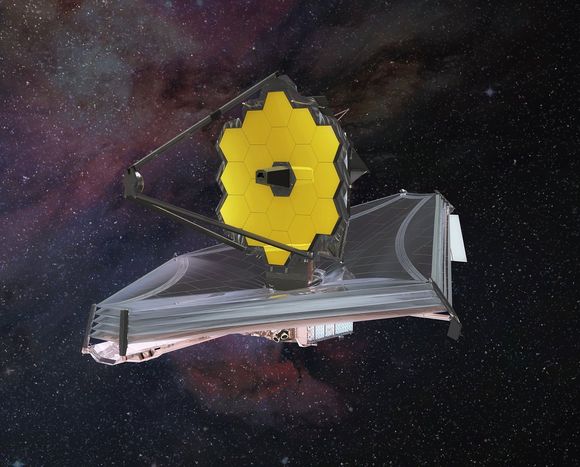The James Webb Space Telescope (JWST) - successor to the Hubble Space Telescope, has finally been safely delivered into space via an Ariane 5 rocket launched from Europe’s Spaceport in French Guiana, the date;- Christmas Day 2021. This highly complex project, long overdue and way over budget, should really be considered a joint collaboration between NASA, ESA (European Space Agency) and the Canadian Space Agency, ultimately costing around $10 billion.
In what will be an almost unbearably tense January for scientists, engineers and astronomers, JWST, the world’s largest and most complex space science observatory, will complete the most difficult and complex deployment sequence ever attempted in space, whilst en-route to reach its observing location at the L2 Lagrange point. It will then spend another five months commissioning, at the end of which JWST will deliver its first images.

The Lagrange L2 halo point 1.5 million km from Earth and location of JWST
There has already been some unexpected, but welcome news concerning the longevity of the JWST mission. According to a NASA update, "the James Webb Space Telescope may have enough fuel to more than double its minimum lifetime thanks to the precision of its launch and the two trajectory corrections the spacecraft has made to date". The JWST team has analyzed its initial trajectory and determined the observatory should have enough propellant to allow support of science operations in orbit for significantly more than a 10-year science lifetime. However, NASA emphasized that it is not providing a new mission timeline as other factors could ultimately affect Webb's duration of operation.
As of writing JWST has already successfully deployed its solar panals and made course adjustments. It has completed deploying both pallet structures of its sunshield, one of numerous milestones in the five-day-long process of unfurling the massive sunshield. It is also already now farther from Earth than the moon's orbit, according to an agency update posted Dec. 27th. You can follow where JWST is and how the mission is unfolding (literally) at https://webb.nasa.gov/content/webbLaunch/whereIsWebb.html
The science JWST will undertake will be ground breaking. Initially JWST will concentrate on eight programmes two of these will concentrate on planetary observations, within our Solar System and Exo-planets and Disks. The Giant Planet Atmospheres Programme, which is being led by Leigh Fletcher of the University of Leicester, will coordinate the telescope's study of our solar systems gas giant planets. JWST will spectroscopically map the atmospheres of both Uranus and Neptune, probe in detail the GRS on Jupiter and investigate how the hexagon polar cyclone in Saturn's northern hemisphere has developed. It is the Exo-planet programme which may yield some profound findings. JWST will not be looking for new Exo-planets, but will better characterise those already discovered - and most likely, be discovered, over the lifetime of the telescope. This will be accomplished by understanding their atmospheric chemistry. "This could mean detecting key molecules in the atmosphere of low-mass exoplanets within the habitable zone, thus providing some insight into possible geophysical and - or, biological activity" says Nikku Madhusudhan of the University of Cambridge and is leading a project to spectroscopically study exoplanets. The exciting prospect is that if biological activity is detected, the inference is that life in some form may also be present.
These tantalising prospects of science changing discovery, along with the many others JWST will hopefully make, are as yet potential ones only. Many hurdles have to be overcome (and these are the known ones) before the telescope can really live up to scientists expectations. It's going to be one rollercoaster of a ride, but certainly not one to miss! By the time of next month's notes JWST should be in situ at L2 and fully deployed. We shall then examine the cosmological programmes JWST will undertake. Keep fingers crossed!
Stop press news:- as of putting the monthly notes to bed, JWST has travelled just over half the distance to Lagrange pt 2 - approximately 450,000km from Earth. It has just rolled up the membrane protective cover and will be commencing deploying the 5 Sun membrane shields. So far, so good.
Images- coutesy of NASA, ESA
- Log in to post comments




